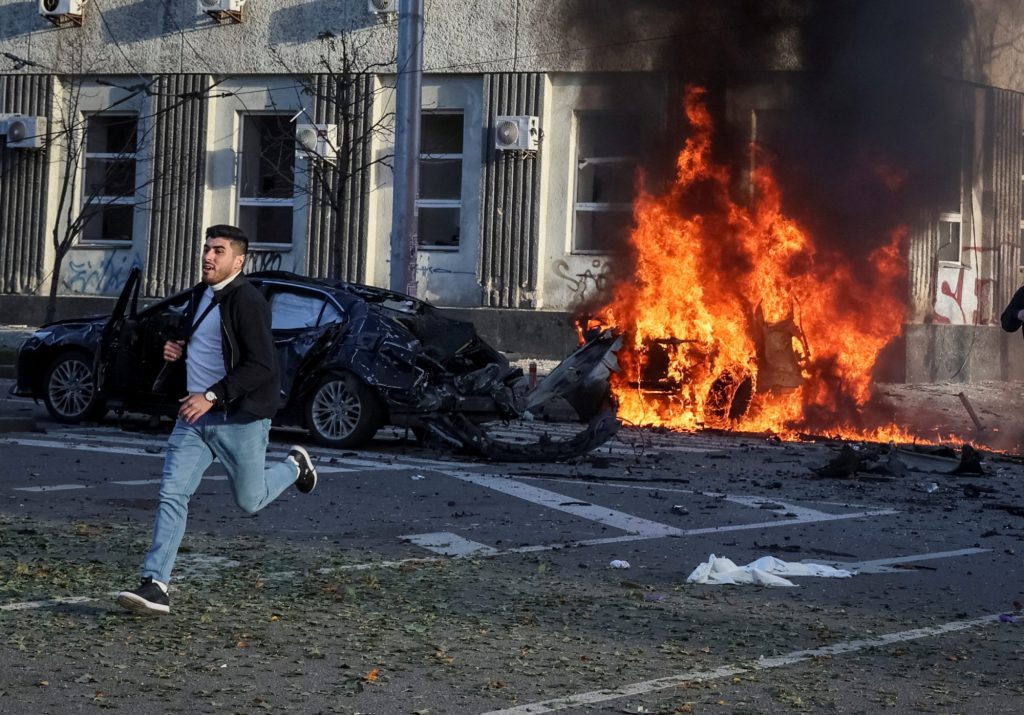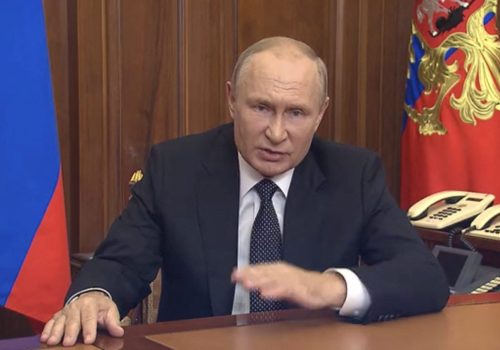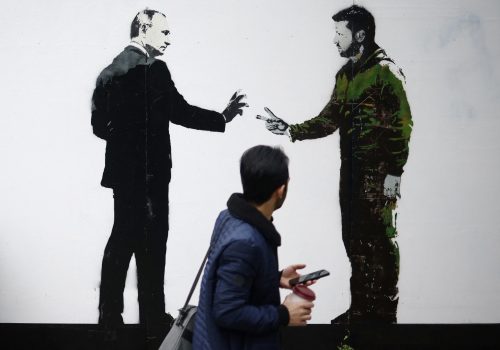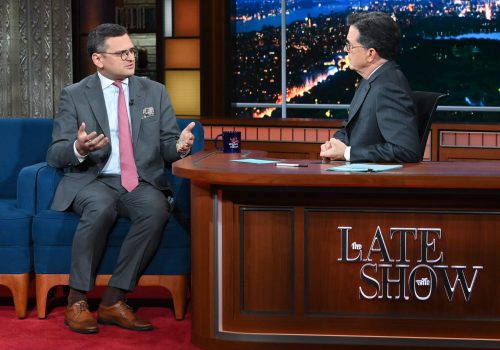Vladimir Putin dramatically escalated his invasion of Ukraine on October 10 with the biggest wave of airstrikes since his army first crossed the border almost eight months ago. Russian forces fired more than 80 missiles and dozens of Iranian-made kamikaze drones at non-military targets across Ukraine, killing at least 19 Ukrainian civilians and leaving dozens wounded while temporarily plunging much of the country into darkness.
In an official address, Putin claimed the airstrikes were in response to a recent attack on the Crimean Bridge, a multi-billion dollar vanity project closely linked to the Russian ruler that connects Ukraine’s occupied Crimean peninsula with the Russian Federation. However, this attempt to portray the strikes as an act of revenge was widely questioned. Skeptics noted that Russia has carried out similar attacks on multiple prior occasions and pointed to the fact that Putin himself had specifically threatened such an escalation almost one month earlier. Speaking in mid-September as his army retreated in disarray from the Kharkiv region, Putin declared that recent Russian airstrikes on Ukrainian civilian infrastructure were a “warning” and promised a “more serious” response if Ukraine’s counteroffensive continued. He appears to have kept his word.
The targets selected for Monday’s precision airstrikes suggest a clear intention to cripple Ukraine’s civilian infrastructure while spreading fear and panic among the Ukrainian population. In addition to a number of energy facilities, Russian missiles also struck a range of civilian locations in the heart of Kyiv including a children’s playground, a pedestrian bridge, a university, and a busy downtown intersection. None of these targets has any conceivable military value.
The strikes appear to have been timed to inflict maximum chaos, with the first wave taking place during the busy morning rush hour as Ukrainians took their children to school and traveled to work. Russia’s missile blitz continued on Tuesday, further undermining earlier claims that this was a response to the Crimean Bridge attack.
Stay updated
As the world watches the Russian invasion of Ukraine unfold, UkraineAlert delivers the best Atlantic Council expert insight and analysis on Ukraine twice a week directly to your inbox.
Putin’s escalation provoked international condemnation but was widely cheered by domestic Russian audiences. In an official statement, US President Joe Biden accused Russia of killing civilians and destroying targets with no military purpose. Biden said the attacks demonstrated “the utter brutality of Mr. Putin’s illegal war on the Ukrainian people.” French President Emmanuel Macron claimed the precision attacks on civilian targets marked “a profound change in the nature of this war.” UN Secretary General Antonio Guterres was quoted as being “deeply shocked” by “another unacceptable escalation of the war,” while a spokesperson for EU foreign policy chief Josep Borrell said the attacks amounted to a “war crime.”
The mood in Russia was jubilant. Putin had been coming under increasing pressure in recent weeks to hit back following a series of humiliating military defeats that shocked the Russian public and punctured the triumphalism of the Kremlin propaganda bubble. The decision to strike Ukrainian civilian targets was widely toasted on Russian social media and greeted by many prominent regime figures as a welcome show of strength. Chechen leader Ramzan Kadyrov, who had been among the most high-profile critics of Russia’s faltering war effort, declared himself “100% satisfied with how the war is being waged” following Monday’s attacks.
Former Russian President Dmitry Medvedev, who currently serves as deputy head of Russia’s Security Council, said the attacks should be seen as the “first episode” in a new phase of the war. Medvedev, who has sought to position himself as a hardliner in the war against Ukraine, argued that Moscow’s ultimate goal should now be the “complete dismantling of the Ukrainian political regime” which he said posed a “permanent, direct, and clear threat to Russia.”
Talk of an entirely new phase in the conflict may be overstating the case. After all, Russian forces have been deliberately targeting Ukrainian civilians and civilian infrastructure ever since the invasion began in February. Nevertheless, the unprecedented scale of this week’s missile attacks does indicate a significant shift in emphasis as Putin seeks to regain the initiative following months of battlefield setbacks.
The Russian ruler’s plans to conquer Ukraine began to unravel from the very first day of the invasion. Advancing Russian troops were told they would be met with cakes and flowers by a grateful population. Instead, they encountered fierce opposition and were forced to retreat from Kyiv after sustaining severe losses. Moscow then attempted to regroup and focus on the occupation of eastern Ukraine’s Donbas region, but this concentrated push soon ground to a halt amid more heavy casualties. The situation deteriorated further in early September when the Ukrainian military launched a stunning counteroffensive that succeeded in liberating much of northeastern Ukraine while leaving the Russian military exhausted and demoralized.
Eurasia Center events

Putin now finds himself confronted with the previously unthinkable prospect of an outright Ukrainian victory and is attempting to rescue his unraveling invasion by raising the stakes. In recent weeks, he has staged fake referendums in occupied regions of Ukraine and hurriedly annexed these areas to the Russian Federation while threatening to defend his newly acquired lands with nuclear weapons. He has also sought to replenish the depleted ranks of his invasion force by announcing Russia’s first mobilization since World War II.
This week’s sudden increase in airstrikes on Ukrainian civilian targets fits neatly into the broader escalatory stance adopted by the Russian ruler. Unable to defeat Ukraine on the battlefield, Putin is now employing terror tactics to break the resistance of the Ukrainian nation.
The man recently appointed by Putin to command Russian forces in Ukraine, General Sergei Surovikin, appears to have been hand-picked for this task. Appointed in early October, Surovikin has a reputation for brutality that helped earn him the nickname “General Armageddon.” This week’s airstrikes are exactly what his admirers were hoping for and offer an ominous indication of Russia’s plans for the months ahead.
Ukrainians has so far responded to the escalation in Russia’s air war with a mix of anger and determination. Ukrainian government officials and members of the public alike took to social media on Monday with messages of defiance and expressions of continued confidence in ultimate victory. International observers appear to agree on this last point, with many noting that the Russian campaign against Ukrainian civilian infrastructure has little military value and is unlikely to change the course of the war.
Nevertheless, Russia’s terror tactics present grave challenges for the Ukrainian population. This week’s attacks highlighted Ukraine’s vulnerability to airstrikes and underlined the country’s urgent need for enhanced air defense systems. Some new systems have recently been delivered and more are already on their way, but Ukrainian officials are currently stressing that further deliveries remain a top priority. With attacks on civilian infrastructure likely to continue during the coming months, measures must also be put in place to repair vital infrastructure, address supply chain emergencies, and secure alternative energy supplies.
Putin’s desperation and his capacity for war crimes should not be underestimated. He knows that if he loses the war in Ukraine, he is unlikely to survive. With military victory proving elusive, he intends to bomb Ukraine back into the pre-industrial age and bring the country to its knees.
Ukrainian Energy Minister Herman Halushchenko has stated that Russian missiles hit roughly 30% of the country’s energy infrastructure during the first two days of Moscow’s blitz. This is just the beginning. Millions of Ukrainians are now facing the grim prospect of a long winter with limited access to water, heating, and electricity. Their plight may not be enough to rescue Putin’s failing invasion, but it could spark one of the worst humanitarian catastrophes of the twenty-first century. The only way to prevent this unfolding tragedy is to provide Ukrainians with the weapons they need to defend themselves and win the war.
Peter Dickinson is Editor of the Atlantic Council’s UkraineAlert Service.
Further reading
The views expressed in UkraineAlert are solely those of the authors and do not necessarily reflect the views of the Atlantic Council, its staff, or its supporters.

The Eurasia Center’s mission is to enhance transatlantic cooperation in promoting stability, democratic values and prosperity in Eurasia, from Eastern Europe and Turkey in the West to the Caucasus, Russia and Central Asia in the East.
Follow us on social media
and support our work
Image: Cars burn after a Russian airstrike. Central Kyiv. October 10, 2022. (REUTERS/Gleb Garanich)




